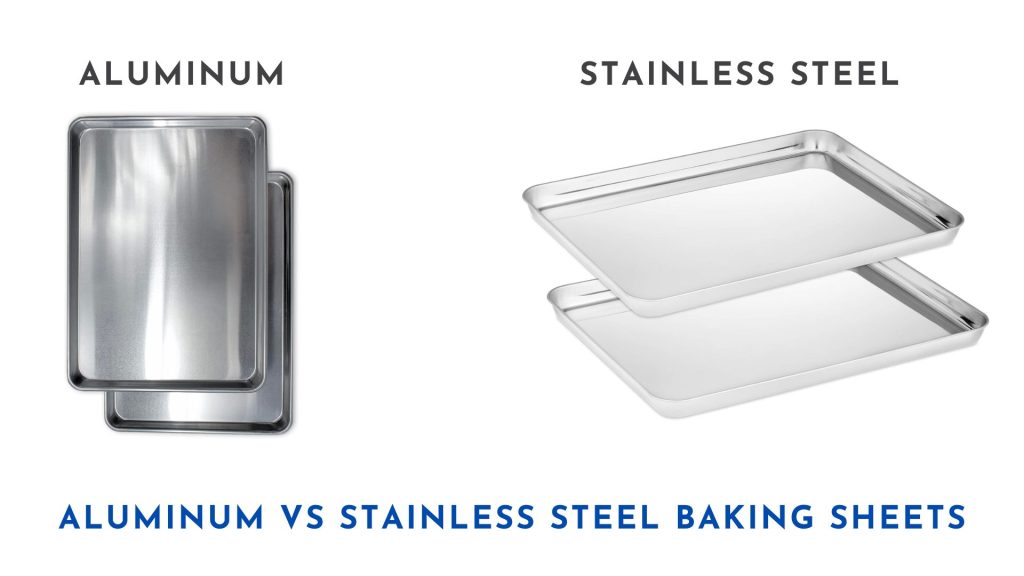When it comes to baking sheets, two of the most popular materials are aluminum and stainless steel. Each has its advantages and disadvantages, and choosing between them depends on your specific needs and preferences. In this comprehensive comparison, we’ll explore the characteristics of aluminum and stainless steel baking sheets, helping you make an informed decision.

Before We Compare, What is a baking sheet?
A baking sheet, often referred to as a cookie sheet or baking tray, is a flat, rectangular, and typically rimmed sheet of metal or other heat-resistant material used for baking and cooking in the oven. Baking sheets are essential kitchen tools for a variety of culinary tasks, including baking cookies, pastries, bread, and other baked goods, as well as roasting vegetables and meats.
Baking sheets come in various materials, with the most common being aluminum and stainless steel. They are designed to provide an even cooking surface, allowing heat to circulate around the food for uniform baking or roasting. Many baking sheets also feature a non-stick surface or are coated to prevent food from sticking and to simplify cleaning.
The rimmed edges of a baking sheet are useful for containing juices and preventing spills in the oven, making them versatile for a wide range of cooking applications. Baking sheets are available in various sizes, with standard sizes such as full sheet, half sheet, and quarter sheet, making it easy to choose the right size for your baking needs.
Aluminum vs Stainless Steel Baking Sheets
Here are the 6 factors to compare between the Aluminum and Stainless Steel Baking Sheets:
1. Heat Conductivity
- Aluminum: Aluminum is an excellent conductor of heat. It heats up quickly and distributes heat evenly across the baking surface. This feature is ideal for achieving consistent baking results, especially for cookies and pastries that require even browning.
- Stainless Steel: Stainless steel, on the other hand, is not as efficient at conducting heat as aluminum. It tends to heat unevenly, which may result in unevenly baked goods. However, some stainless steel baking sheets come with an aluminum core to improve heat distribution.
2. Durability
- Aluminum: Aluminum baking sheets are generally less durable than stainless steel. They can warp, dent, and scratch easily, which affects their longevity. Some aluminum sheets are coated to mitigate these issues.
- Stainless Steel: Stainless steel baking sheets are known for their durability. They are resistant to warping, denting, and scratching. With proper care, stainless steel sheets can last for many years.
3. Reactivity
- Aluminum: Aluminum is a reactive metal, which means it can interact with acidic or alkaline foods, potentially affecting the taste of your dishes. To avoid this, many aluminum baking sheets are anodized or coated with a non-stick material.
- Stainless Steel: Stainless steel is non-reactive, making it an excellent choice for baking sheets. It won’t react with acidic ingredients, ensuring the flavors of your dishes remain unaltered.
4. Maintenance
- Aluminum: Aluminum sheets are relatively easy to clean but can discolor over time. Some require special care to prevent discoloration and maintain their appearance.
- Stainless Steel: Stainless steel baking sheets are straightforward to clean and maintain. They don’t discolor and are often dishwasher safe.
5. Price
- Aluminum: Aluminum baking sheets are generally more affordable than stainless steel. They are a budget-friendly option for those looking for basic baking sheets.
- Stainless Steel: Stainless steel baking sheets are usually more expensive due to their durability and non-reactive properties. They are a long-term investment for serious bakers.
6. Aesthetics
- Aluminum: Aluminum sheets can look less attractive over time due to discoloration and potential scratching. They might not maintain their initial shine.
- Stainless Steel: Stainless steel baking sheets are known for their timeless and elegant appearance. They retain their shiny finish even after years of use.
Conclusion
In the aluminum vs stainless steel baking sheet comparison, the choice ultimately depends on your priorities. If even heat distribution and affordability are your main concerns, aluminum is a suitable option. However, if you value durability, non-reactivity, and long-term performance, these stainless steel baking sheets are the way to go. Stainless steel might have a higher upfront cost, but it pays off with its longevity and consistent baking results. Consider your baking needs and preferences to make the right choice for your kitchen.